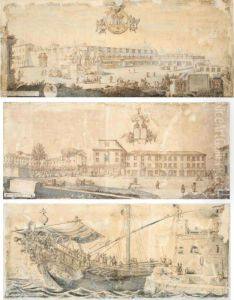Carlo Fontana Paintings
Carlo Fontana was an influential Italian architect and stage designer, born in 1634 in Brusata, now part of Novazzano, in the Swiss canton of Ticino. His career flourished during the late Baroque period, significantly contributing to the architectural landscape of Rome and beyond. Fontana's work is characterized by a masterful blend of traditional Baroque elements with emerging trends of the late 17th and early 18th centuries, showcasing his ability to adapt and innovate within the evolving aesthetic of his time.
Fontana moved to Rome in the 1650s, where he became a student and collaborator of Gian Lorenzo Bernini, one of the most prominent architects of the Baroque era. Under Bernini's guidance, Fontana contributed to several major projects, including the design and construction of the new apse of St. Peter's Basilica. His association with Bernini significantly influenced his architectural style and helped establish his reputation in Rome.
In the latter part of his career, Fontana emerged from Bernini's shadow to become a successful architect in his own right. Among his most notable works is the façade of the Basilica of Santa Maria in Trastevere (1682-1686) in Rome, which exemplifies his mature style. He also designed the monumental fountain in Piazza San Pietro and was involved in urban planning projects, including the design of new streets and squares that contributed to the grandeur of Baroque Rome.
Fontana's work was not confined to Rome; he also undertook projects in other parts of Italy and abroad. His influence extended through his numerous pupils and followers, spreading his architectural ideas across Europe. Fontana was also an accomplished scholar, and his treatise on the ancient Temple of Solomon was highly regarded by his contemporaries. This work, along with other writings, played a significant role in the dissemination of architectural knowledge during his time.
Carlo Fontana died in 1714, leaving behind a legacy that had a lasting impact on the development of Baroque architecture. His innovative designs and scholarly works continue to be studied and admired for their contributions to the field of architecture.
